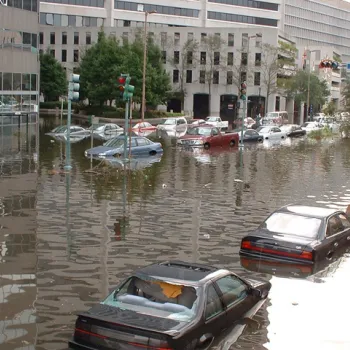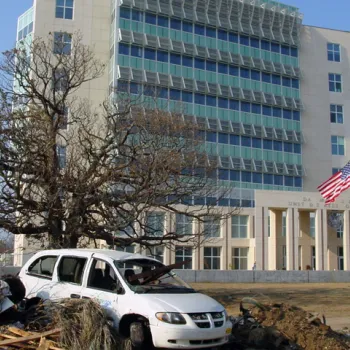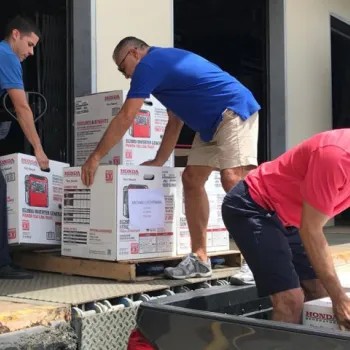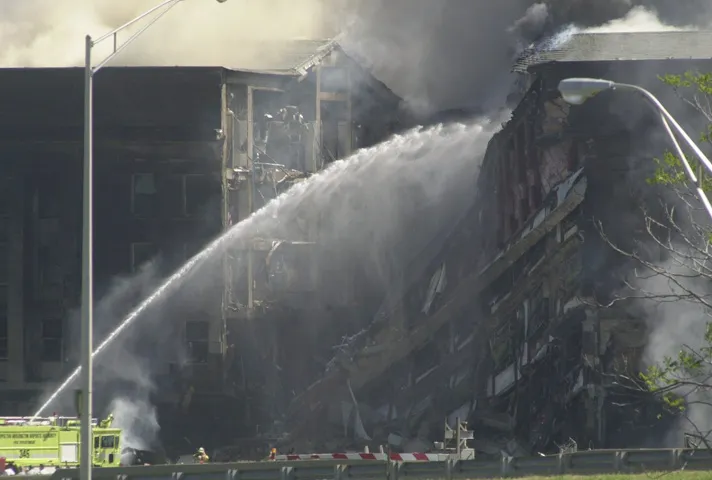
Shortly after the Pentagon was struck by a hijacked jet on Sept. 11, 2001, the Judicial Conference of the United States abruptly closed its session at the Supreme Court. Credit: Department of Defense
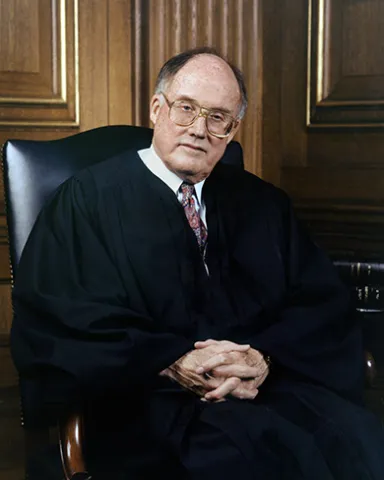
Chief Justice William H. Rehnquist
Credit: U.S. Supreme Court Historical Society
The fall session of the Judicial Conference of the United States was off to an uneventful start. On the agenda were policy questions related to online case records and increasing daily juror payments from $30 to $40.
Leading the meeting in the Supreme Court’s East Room was Chief Justice William H. Rehnquist. Known for his quick, decisive manner, Rehnquist usually got through the Conference’s agenda in a few hours.
This session, held Sept. 11, 2001, would be different. It was the only meeting in the Conference’s 100-year history that would be halted before it could be concluded. The Conference completed essential business by mail ballot about a week later.
Rehnquist abruptly closed the meeting around 10 a.m., a half hour after it started, and was led away by U.S. Marshals personnel. The other judges were ushered out of the Supreme Court, unsure what to do next.

Judge Carolyn Dineen King
“I remember it like it was yesterday,” said Judge Carolyn Dineen King, then-Chief Judge of the U.S. Court of Appeals for the Fifth Circuit. “We got outside the building, and it was just chaos. All you had to do was stop for one minute and some police officer would scream at you.”
September 11 was the first of several national emergencies that have challenged the Judicial Conference in the last 25 years. Although the immediate result was confusion, the terrorist attack had a profound and lasting impact on how the Judiciary operates today.
With help from the Judicial Conference, the Administrative Office of the U.S. Courts (AO), and Congress, courts have learned to plan for — and respond effectively to — natural disasters, civil disturbances, and a global pandemic.
“9/11 was a turning point for courts to realize they had to have a plan for courts to keep going,” said Melanie Gilbert, longtime chief of the AO’s Facilities and Security Office, who recently left the AO for another senior government position. “As these events began to cascade, courts recognized that this is serious. They began to practice all sorts of scenarios.”
On September 11, an exceptionally pretty and temperate day in Washington, little of that planning was in place. Judges inside the Supreme Court building were unaware that a terrorist attack was underway.
Several were puzzled when a staffer briefly stopped Rehnquist during discussions, whispering a message to him. “One of the things you did not do was interrupt that meeting,” King recalled. “I mean that. It was a ticket to trouble.”
A short time later, a second employee came to Rehnquist with a written note.
“The chief justice said, as only he can, ‘Leave all your papers right where they are. I want you to get up and walk out of this room, and follow instructions about how to get out of the building,’” King recalled. Rehnquist was escorted away to an undisclosed location, adding to the other judges’ confusion.
Only gradually as Judicial Conference members left the Supreme Court did they learn of the tragedy unfolding in New York and at the Pentagon. Amid reports that a fourth hijacked jet — which later crashed in Pennsylvania — was flying toward Washington, urgent evacuations were underway across the street at the U.S. Capitol.
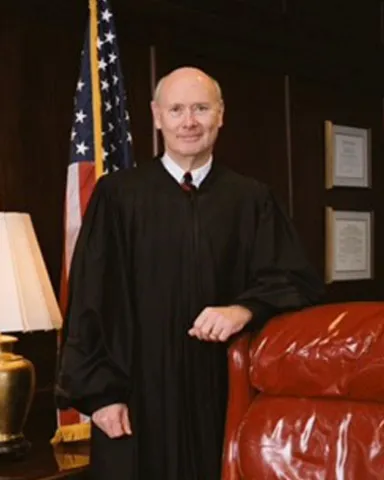
Judge John W. Lungstrum
Walking back to their hotel a few miles away, the judges were “like lost sheep,” recalled District Judge John W. Lungstrum, of Kansas, then chair of the Court Administration and Case Management Committee. It felt surreal to him as he passed an impromptu sidewalk news conference by then-Tennessee Senator Fred Thompson.
“It honestly reminded me of an old-fashioned horror movie,” Lungstrum said. “People were streaming out of all the buildings around Capitol Hill, looking at the sky. Thinking, is something more going to happen?”
With all commercial air traffic shut down across the country, most judges scrambled to join hastily arranged carpools out of Washington. Early on Sept. 12, King rode south in a van with six or eight judges, several of whom were dropped off in Virginia and the Carolinas. After spending the night in Atlanta, she eventually was driven home to Houston.
Judge Thomas F. Hogan, then chief judge of the U.S. District Court for the District of Columbia and the court’s representative to the Conference, only had to walk a few blocks to reach his own courthouse, but he saw firsthand the chaos his staff had been thrown into. Many employees tried to go home to care for their families, only to return in less than half an hour.
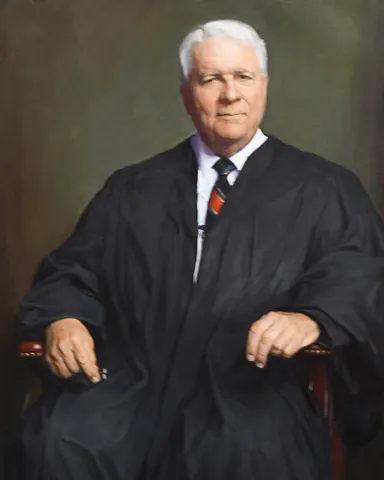
Judge Thomas F. Hogan
“They couldn’t get out because the traffic was just stopped,” Hogan said. “It finally lightened up around 6 p.m., and people left.”
Since September 11, Continuity of Operations Planning, also known as COOP, has played an increasingly central role in Judiciary operations.
A month after the attacks, then-AO Director Leonidas Ralph Mecham, director of the AO, communicated the Judiciary’s security needs to Congress. At the time, every court was urged to put a senior court executive in charge of emergency planning, and to develop a plan to continue operations in all circumstances.
Heightening the urgency was an anthrax scare in October 2001 that forced the Supreme Court to move temporarily to the E. Barrett Prettyman Courthouse in D.C. It was the first time the justices convened away from the Supreme Court building since it opened in 1935.
In 2002, the AO worked with COOP experts to develop a national template plan for operating during emergencies. Assisting were personnel from federal courts in Manhattan, who had learned hard-earned lessons following Sept. 11.

Fallout from the September 11, 2001, World Trade Center attack affected much of southern Manhattan, including three federal courts located about a mile from Ground Zero.
Located barely a mile from Ground Zero, the U.S. Court of Appeals for the Second Circuit, and the district and bankruptcy courts in the Southern District of New York, had worked through a nightmarish series of obstacles: curtailed building access, information technology disruptions, and physical contamination of courthouses from debris caused by the attack.
Lacking written guidelines, “Our emergency plan was something we developed hour by hour, day by day, individually and together, asking ‘OK, what do we need to do to operate,’” recalled Karen Milton, then-Circuit Executive of the Second Circuit, in a July 2002 interview. “The beauty of having a developed, written plan … is that everyone will know the drill.”
In 2005, Hurricane Katrina further accelerated the Judiciary’s focus on COOP planning.
King, who was in Washington during the Sept. 11 attacks, was still chief judge in the Fifth Circuit when Katrina devastated New Orleans, and disrupted courts in Alabama, Louisiana, and Mississippi.
When her court building in New Orleans could not reopen, King persuaded the federal courthouse in Houston to provide space for New Orleans-based personnel. At the urging of the Judicial Conference, Congress passed emergency legislation so that district and appellate courts could operate outside their boundaries when their own court facilities were unavailable.
For more than three months, more than 90 Fifth Circuit employees lived with their displaced families in Houston. They conducted business in cramped quarters while coping with hurricane-related struggles back in New Orleans. In December, King and her husband, Thomas M. Reavley, also a judge in the Fifth Circuit Court of Appeals, honored their staff.
“Some of them had family members die. Some of them had a lot of wreckage. I mean, these were saints, every one of them,” King recalled. “So we needed to do a wonderful lunch and then send them all back to New Orleans for Christmas. It went very well, they were happy.”
In addition to greater planning, technology has helped courts cope with disasters.
When Cedar Rapids, Iowa, suffered heavy flooding in 2008, staff from the Northern District of Iowa were able to access the court’s computer network and work remotely.
By 2012, when Super Storm Sandy flooded lower Manhattan, all the courts lost electricity for a week, but the bankruptcy court continued to receive online filings. In the District Court, emergency hearings resumed almost immediately, with limited generator power.

With only limited electricity available after Super Storm Sandy in 2012, U.S. District Judge P. Kevin Castel presided over a time-sensitive hearing using a table lamp and natural sunlight to light the courtroom. Credit: Southern District of New York
In a 2012 account written after Sandy, then-Chief Judge Loretta A. Preska summarized the many challenges confronting the Southern District of New York. Staff worked with the post office to reroute mail. Judges, employees, jurors, and litigants were shuttled to and from pickup spots near the courthouse. The U.S. Marshals Service helped get fuel delivered over closed bridges — keeping the court’s emergency generators in operation.
“If there is one lesson that Sandy affirmed, it is that a good game plan is critical,” Preska wrote.
In the fall of 2017, a terrible trio of Hurricanes Harvey, Irma, and Maria devastated Texas, Puerto Rico, the U.S. Virgin Islands, and Florida, closing multiple courthouses. Court staff at the Santa Rosa, California, courthouse were beset by a different weather-related disaster: some of the deadliest wildfires in the state’s history.
Throughout the crises, judges and court personnel, Roberts noted in his year-end message on Dec. 31, “responded in dedicated and even heroic fashion.”
By the time COVID-19 forced many courthouses to close their buildings in 2020, most courts and the AO conducted regular practice exercises on how to work remotely during emergencies.
The Judiciary’s 94 district courts, 90 bankruptcy courts, and 13 courts of appeals continued to receive electronic filings and process cases with surprisingly few disruptions, and even adapted quickly to conducting essential court proceedings by video.
Gilbert noted that the AO’s Emergency Management Branch continues to provide guidance, training, and exercises to assist the Courts. As a result, the Judiciary’s preparedness and resilience in the face of emergencies continues to improve.
“It’s a transformed branch from what it was prior to 9/11,” said Gilbert. “It was almost like we’ve been building to the most catastrophic COOP event you could imagine. The pandemic didn’t last two days or two weeks, it lasted more than two years. But we kept courts going, and we eventually figured out how to get back on site.”
Judicial Conference at 100
Learn about how the Judiciary’s national policy making body has grappled with many issues to mark the 100th anniversary of the Judicial Conference of the United States.
Subscribe to News Updates
Subscribe to be notified when the news section is updated.

